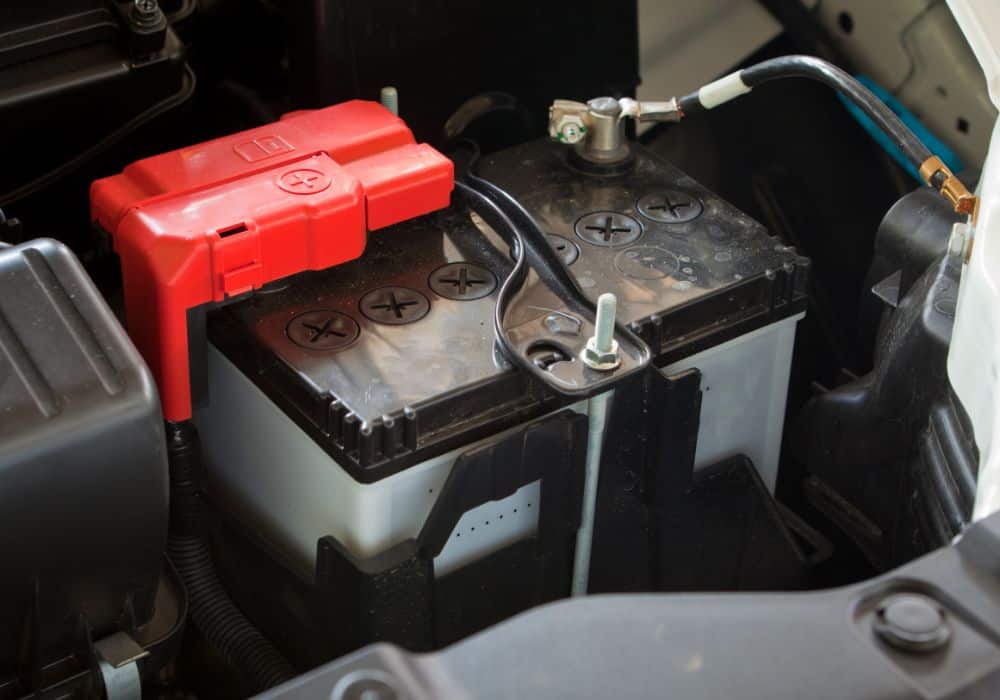It’s difficult to say exactly how many amp hours is a car battery. It could be 35 Ah or 100 Ah. It all comes down to the size, type, and speed of the vehicle that the battery is fueling. However, there is a general formula that can help you calculate the amp hours in your respective car battery.
Read on to learn more about this formula and how to use it. We’ve also shared a guideline on reading and comprehending car battery amperage, along with some useful tips concerning battery replacement and recharge. Let’s dive in!
Table of Contents
How many Ah is a car battery?
Ah, ampere-hours, and Ah rating – these are all different names for the same phenomenon. They refer to the flow of current from the battery to the car in a span of one hour. For example, if a car battery has a 100 Ah battery, it means it can supply 100 amperes for one hour.
The same battery can supply 25 amperes for four hours and 50 amperes for two hours. It depends on the gear or current speed setting of the car. Different gears (or speed settings) draw different amperes and this affects the total run time.
Usually, the average Ah suitable for a car is mentioned on its recommended battery body. For example, here are the company-suggested amp hours for the following cars:
- Ford Explorer – 65 Ah (65000 mAh)
- Toyota Corolla – 45 Ah (45000 mAh)
- Toyota Camry – 38 Ah (38000 mAh)
Given this, a quick answer to how many amp hours is a car battery would be 50 Ah to 70 Ah. That’s the average considering the majority of mid-range cars around the world. Read further to uncover how you can calculate the accurate Ah for your car.
How are amp hours calculated?

Before we get to the math, know that two metrics tell us about a battery’s capacity. These are:
- Watt Hours
- Amp Hours
Calculating both requires a fixed metric of the car, i.e., battery voltage. You can find this metric mentioned either in the manual of the vehicle’s battery or on its body.
Alternatively, you can use a multimeter to measure the voltage of the car battery.
Once you have the voltage, you can calculate the battery capacity in the following ways:
Amp Hours
The formula for calculating watt hours is as follows:
Watt hours = Power in Watts x Hours
You can find the power of your car battery either on its manual or its body. Once you have the watt hours, divide the watt hours by volts, and you’ll get the amp hours.
Amp Hours = Watt Hours / Voltage
Watt Hours
Calculate the watt hours using the following formula:
Watt Hours = Voltage x Amperes
You can measure the amperes using a multimeter as well.
The formula above gives you the watt-hours or the power consumed by the car. Suppose you operate a 12V battery at 20 amperes. The watt-hours will be 240 Wh. Similarly, if you operate the same battery at 25 amperes, the watt hours will be 300 Wh.
It is worth noting that a lot of car battery manuals mention average amp hour rating like this:
12V25
It means the 12-volt battery operates at 25 amperes.
Importance of Car Battery Capacity

Why do we even want to know how many amp hours is a car battery?
Well, we want to know because the capacity or Ah of a car battery determines how long the battery will last. A car battery at 70 Ah continuously powers the engine at 3.5 amp for 20 hours. After this, it will need to recharge. You can still drive your car as it recharges its batteries. But it may impact the overall life of the battery.
Battery capacity also determines the speed of the vehicle and the electrical accessories that it can support. For example, a car will require more power than usual to support extra lights, additional navigation systems, sound systems, etc.
With that said, the average life of a car battery is about 3- 5 years. Some manufacturers also promise a seven-year-long life. But if you try using a car battery beyond its warranty period, you risk your safety. The battery may fail anytime.
For that very reason, it’s essential to keep a keen eye on the battery’s current condition, capacity, and remaining life.
What does CCA mean on a car battery?
CCA is short for cold cranking amps. It is a rating that indicates how well a battery can start an engine in cold weather.
Ideally, a good battery for a small car should have a 150 CCA rating at 0 degrees Fahrenheit. And it should stabilize the voltage of a 12V battery at 7.2 volts at least. For bigger vehicles, an ideal CCA rating is about 500-600.
By the rule of thumb, the higher the CCA rating is, the better. But it only benefits those who are living in cold climates. For warmer climates, there’s no point in buying expensive batteries just for higher CCA.
With that said, is any CCA rating too high? Can a high CCA rating damage your vehicle?
Actually, no. A battery with a high CCA rating will work perfectly fine under all circumstances. However, it might not benefit you if you are living in a warm place.
What happens if I put a higher amp battery in my car?
The consequences of putting a higher amp battery largely depend on how high you’ve decided to go. Increasing the amp slightly more than the vehicle’s average Ah rating is acceptable. It will improve the performance and increase the storage capacity.
Naturally, the battery will also last longer with an increased storage capacity. And that will make your vehicle much more energy-efficient.
However, if you choose to upgrade the amperes by a significant difference (3x or 10x the original Ah rating), there’s a high chance it will increase the load on your alternator and slow down the charging process. Instead of improving the system, it’ll damage all the connected electronics. Plus, the CCA may increase unreasonably.
So, be careful with the number of amps you increase. Make sure you also consider the space available within the engines. Usually, car batteries with higher amps are bigger too.
How to choose the best car replacement battery?

When shopping for a replacement car battery, there are a few factors you must consider to ensure that the battery is a perfect fit for your vehicle. These are:
1. Size
Determine the size of the battery tray in your car and look for a battery that has the right physical dimensions and terminal locations. You’ll find automobile batteries grouped into sizes to fit the needs of different models. The most common size groups include:
- Size 34/78: General motor cars and some Chryslers
- Size 34: Majority of Chrysler cars
- Size 35: Recent models of Nissan, Honda, and Toyota
- Size 65: Mercury cars, Lincoln, large-sized Ford
- Size 75: Most general motor cars
2. Age
Recently manufactured car batteries feature the latest technologies and tend to last longer than older ones. Hence, it’s best to opt for a car battery manufactured less than six months ago.
You can check out the date yourself by assessing the 2-character code given on the battery manual or the battery’s body. One of the characters will be an alphabet, and the other will be a digit. Here’s how to read both:
- Character 1 (Alphabet): These range from A to L. A represents January, B represents February, C represents March, and so on.
- Character 2 (Digit): These range from 0-9. They represent the last digit of the year. Every decade the cycle resets.
For example, say a battery reads A2. It means it got manufactured in January 2022.
3. Battery Capacity
Assess if the battery capacity is compatible with your vehicle’s needs. You can use the formulas given above to determine this. Calculate watt hours and Ah rating and compare.
4. Warranty
It’s best to research brand reputation and opt for a trusted name. Along with reputation, also check out the brand’s confidence by evaluating their return and refund policy. Typically, a car battery comes with 24 months of warranty.
FAQs

1. What does 35Ah mean in battery?
35 Ah refers to a 35 amp-hour battery, i.e., a battery that can deliver 35 amperes in one hour. The battery may last for an hour or up to 20 hours depending on the type of battery and current drawn.
2. How much Ah are 12-V batteries?
Scroll above, and check out the formulas we’ve shared for calculating the Ah of a battery. According to these formulas, you cannot calculate the Ah without amperes or watt-hours. Since we do not have either, it’s difficult to say how much Ah are 12-volt batteries.
3. What is a deep-cycle battery?
Deep-cycle batteries are one of the two major types of lead-acid batteries (i.e., the batteries used in cars). These batteries have a shorter charging time. And they can last longer than a starter battery without charging. They are more energy efficient and hence, are becoming increasingly popular.
Final Words
Summing up, there’s no definite answer to how many Ah is a car battery. Ideal Ah rating is unique for each vehicle, depending on its usage, model, and needs. We hope the guide above helps you figure out the Ah rating of your car and that the tips come in handy for future battery buys.
If there’s still confusion, feel free to drop your questions in the comments below. We’ll get back to you soon!
